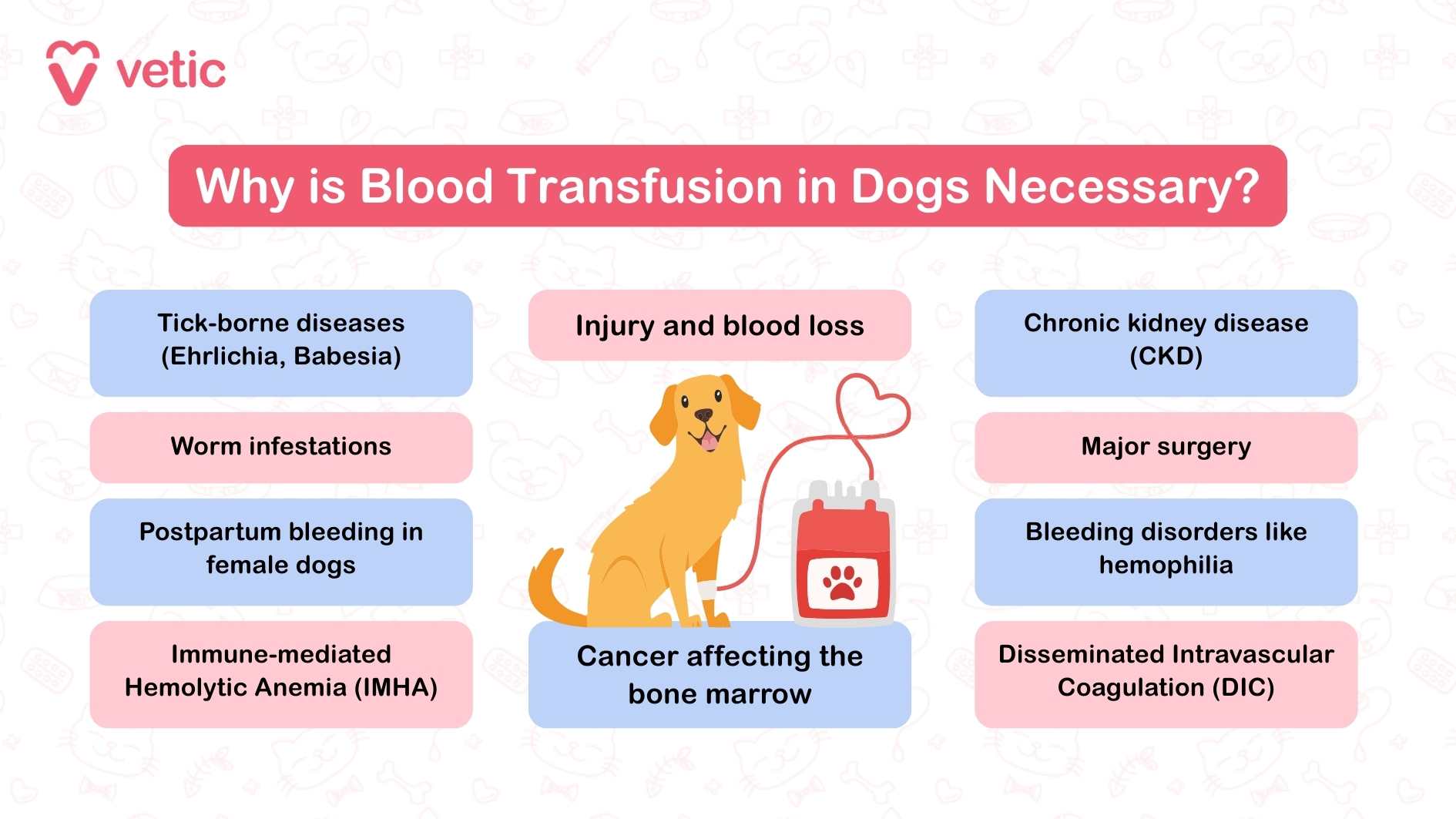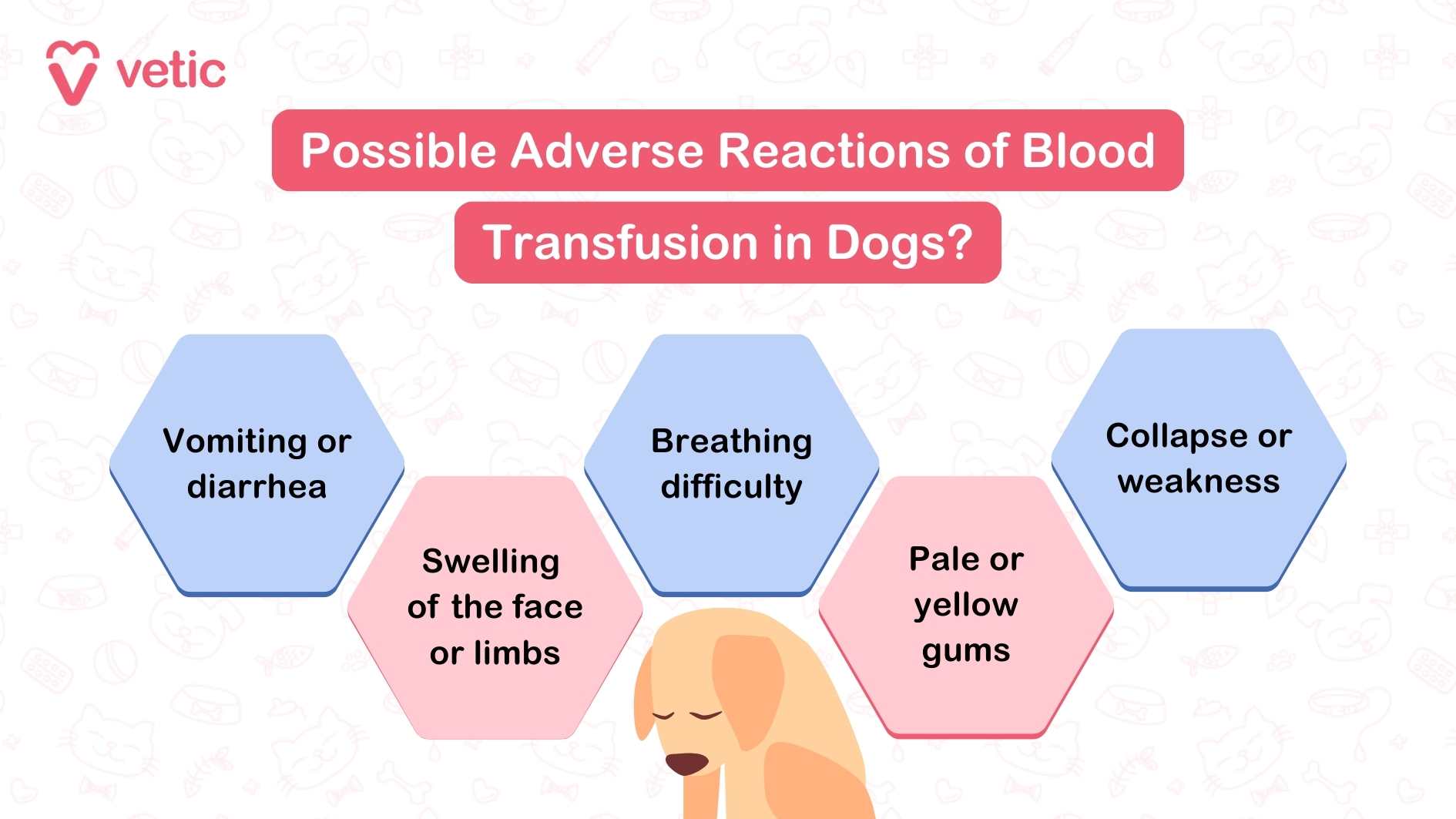Dogs do require blood transfusion from other dogs when they lose too much blood. Blood transfusion in dogs also requires blood type matching just like in humans. However, while humans have only 8 blood types, dogs have more than 12. That makes blood transfusion in dogs a little more complex.
So, here’s everything you need to know about blood transfusion in dogs, blood types and how blood transfusion works.
What is the need for blood transfusion in dogs?

Blood transfusion is an emergency procedure in dogs. A dog may need a whole blood transfusion for at least one of the following reasons –
- Anaemia due to haemoprotozoa (Ehrlichiosis and Babesiosis)
- Anaemia due to endo-paratises (hookworms or ascariasis)
- Severe blood loss due to external injuries
- Immune mediated haemolytic anaemia (IMHA)
- Disseminated intravascular coagulopathy (DIC)
- Blood loss during surgery
- Bleeding disorders
- Chronic kidney disease
Blood transfusion is a part of an emergency treatment for any of the above-mentioned conditions. For the actual treatment of the dog, the cause of blood loss should be diagnosed and addressed.
What are the different blood types of dogs?
Dogs have at least 12 different blood types. The most common and medically significant blood type in dogs being DEA 1 (Dog Erythrocyte Antigen 1). Initially, the major blood types were categorized as DEA 1.1 and DEA 1.2, but now they are referred to as DEA 1 positive and DEA 1 negative.
The other blood types include DEA 3, 4, 5 and 7. DEA 6 and 8 testing is no longer available due to low availability of standardised antisera. They do not cause serious transfusion reactions or rejection reactions like DEA 1, so they aren’t considered high priority in the present times.
Another significant antigen sometimes found in mixed breeds, labrador retrievers, golden retrievers and beagles is the Dal antigen. Most common breeders and mixed breed dogs have the Dal antigen.
How is blood typing done for blood transfusion in dogs?
Blood typing should be done before any blood transfusion in dogs. Testing methods for DEA 1 include card-based agglutination or optical agglutination.
Here are some of the most common blood typing tests before blood transfusion in dogs –
Card Agglutination Test (RapidVet-H)
This is a quick and easy in-clinic test for DEA 1. A drop of the dog’s blood is mixed with a reagent on a special card. If the blood clumps (agglutinates), the dog is DEA 1-positive. It’s commonly used but can sometimes give false positives, especially in dogs with immune-mediated hemolytic anemia (IMHA).
Immunochromatographic Strip Test
This method uses a test strip that shows a visible line if DEA 1 antigen is present. It’s easy to use and provides highly accurate results with fewer false positives.
Gel Column Agglutination
This method uses a gel matrix to detect clumping of red blood cells. The clumped cells are trapped in the gel, and the strength of the reaction can be visually graded. It’s more sensitive than the card test and provides objective results, but it requires a centrifuge and some technical training.
Laboratory Typing (Very Rare)
Full blood typing for less common antigens like DEA 3, 4, 5, and 7 is only available through reference labs. This testing is thorough and ideal for blood donor screening, but it’s not practical in emergencies due to longer turnaround times.
Crossmatching
While not a typing test, crossmatching is crucial before giving a second blood transfusion. It checks compatibility between donor and recipient by mixing their blood to detect any adverse reaction. It doesn’t tell the exact blood type but helps prevent transfusion reactions. It can be done using slide, tube, or gel methods, with or without Coombs reagent.
It’s crucial to test any canine recipient for DEA 1 since they will become sensitized within 4 days. They will develop an antibody against the “foreign” antigen, which will cause severe transfusion reactions if the recipient receives a second transfusion.
Which dogs can donate blood for blood transfusion in dogs?

In the case of a true emergency, such as an accident or uncontrolled blood loss, any dog can donate blood – theoretically! However, the ideal blood type for donation is DEA 1 negative. Veterinarians do look for additional qualities in the donor, including –
- Adult dog
- Body weight of at least 25 kg (healthy for their size and not obese)
- Fully vaccinated
- No haemoprotozoa (E. canis, Babesia or Anaplasma)
- Healthy (no heart or kidney diseases)
- Not on any medication
- No infectious diseases and parasites
- Calm (able to sit for 20 mins when blood is collected)
- DEA 1 negative
If the recipient and donor both are DEA 1 positive, in that case the transfusion can be done without any risk of significant immune response.
What is the Complete Process for Blood Transfusion in Dogs?
If your dog ever needs a blood transfusion, it can sound a little scary. But knowing what happens during the process can help you feel more at ease. Here’s a simple breakdown of how vets find a match and what takes place during the transfusion.
Step 1: Finding a Blood Donor for Your Dog
Vets have two main options when they need blood for a transfusion:
They can take blood from a healthy donor dog that’s available at the clinic.
Or they can request blood from a pet blood bank. These are available nationally, and many emergency or specialty clinics also have their own supply.
Step 2: Checking for a Match
Before the transfusion, it’s very important to make sure the donor dog’s blood is a safe match for your dog.
Here’s how that’s done:
- The vet will take a small blood sample from your dog and mix it with a sample from the donor.
- Then they reverse the process – mixing donor blood with your dog’s, just to double-check.
This helps make sure there won’t be any bad reaction. For example, if a dog with DEA 1 Negative blood receives DEA 1 Positive blood, their immune system could attack the new cells, which can be dangerous.
So, once both dogs are tested for blood type (especially DEA 1), a second check called a crossmatch test is done to confirm everything is safe.
Step 3: Giving the Transfusion
Once a match is found, the donor blood is collected in special bags that prevent clotting. These bags are connected to an IV line with a filter and given directly into the dog’s vein.
The amount of blood your dog gets depends on:
- Their weight
- How much blood they’ve lost
The transfusion is given slowly, and your dog will be watched very carefully for any signs of a reaction. Vets monitor things like breathing, heart rate, and body temperature the entire time.
What Happens After?
In many cases, just one transfusion is enough to help your dog recover. But if your dog has a condition that keeps causing blood loss or damage to red blood cells, more transfusions might be needed.
Are blood transfusions in dogs successful?
Usually, dogs require just one transfusion for recovery, unless they have IMHA or a blood parasite that causes the continuous loss of blood. When the major blood types are matched, blood transfusions in dogs should be successful. Depending on whether the blood was taken from a donor directly, the lifespan of the RBCs should be around 180 days.
We must remember that blood transfusions are a temporary and, sometimes, emergency solution. Veterinarians must address the root cause of blood loss to ensure the recipient dog does not require repeated transfusions. The recipient dog should begin receiving therapy and treatment to maintain a normal level of RBC and platelets within the 110 days from transfusion.
What is the survival rate for dogs with blood transfusions?
Blood transfusions in dogs are usually life-saving and safe when all protocols are followed. The survival rate for dogs with blood transfusions depend directly upon the underlying condition of blood loss. It is also influenced by the dog’s overall health.
The survival rate can be as high as 80% in most healthy dogs who require a one-time emergency transfusion, unless their health status is complicated by co-existing conditions or severity of the trauma/injuries.
How long does a blood transfusion last in a dog?

Transfused RBC from a donor directly typically has a lifespan of around 110-120 days. However, if the whole blood comes from a blood bank, the lifespan will depend upon how long the blood was stored. The longer whole blood is stored in the bank, the shorter the lifespan of the RBCs becomes.
If there’s no continuing blood loss or destruction of RBCs in the system of the recipient dog, approximately 70% of the donor’s RBCs remain in circulation for 110 days.
What are the risks of adverse reactions after blood transfusion in dogs?
If the blood types do not match, for example, the recipient is DEA negative and the donor is DEA positive, there will be a strong transfusion reaction. Since it is an immunologic reaction, the signs will be that of a serious allergic reaction.
The signs of transfusion reactions are –
- Fever
- Rashes and hives
- Itching
- Skin irritation
- Vomiting
- Diarrhoea
- Rapid breathing
- Rapid heart rate
It is important to keep the recipient dog in observation for at least 24 hours. If any reaction is noticed, veterinary professionals can administer emergency medicines to stabilise them.
What are the side effects of a blood transfusion in a dog?

Apart from the transfusion reaction you should also consider other possible side effects. These are responses expected after a blood transfusion in a dog.
- Mild fever
- Lethargy
- Tiredness (temporary)
- A slight increase in heart rate
- Nausea and loss of appetite
- Shivering and restlessness
- Changes in breathing rate
These are different from transfusion reaction signs in dogs. However, to the pet parents’ eyes, the signs and symptoms often look indistinguishably similar.
Hence, we always insist on at least one overnight stay so the veterinarians can monitor the patient and ensure their safety.

